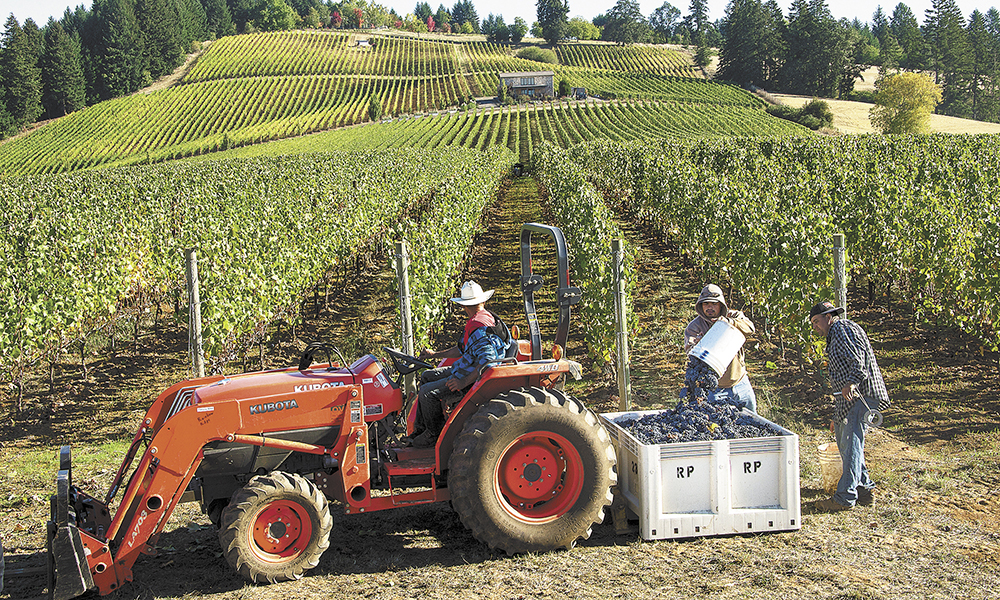Picking Logistics
Many moving parts for this year’s beautiful, bountiful harvest.
While many might have romantic visions of people harvesting grapes by the bucket to be made into wine, those of us on the ground, realize the physically and emotionally demanding side of harvest: late nights counting punch cards, shuttling bins back to vineyards for the next day’s pick, early mornings scrambling to remember the important items and trying hard to keep everyone happy, including winemakers, owners, farm labor contractors and picking crews.
A typical day might start with running out the door with no breakfast but coffee in hand. Then the all-important mug is promptly knocked over and lost as soon as picking starts. Snip, snip, snip is what you hear until the first buckets come flying in your direction. Thoughts of the beautiful sunrise vanish as you lean over, pulling leaves and other debris out of the bins as fast as you can, in between punching pickers’ cards for each bucket they haul up or down the rows. And so goes another day of harvest…
This year’s long harvest kept crews picking steadily. It started for many people the second week of September and finished the second week of October. This helped keep harvest costs more stable, but some people paid higher prices to ensure they had a crew or paid higher rates due to poor picking conditions — lots of leaves in the fruiting zone, steep hills or low yield.
Pickers were paid anywhere from $1.30 to $2 per bucket of grapes. This figure comes out to around $185 to $300 per ton of grapes. For fast pickers, this is equivalent of $25 to $40 per hour, or around $200 each day. A five-gallon bucket of grapes weighs, on average, 18 to 22 pounds. The hardest part of the job is carrying the buckets from the rows to the picking bins.
Managing crews picking by the bucket has its advantages as well as headaches. Paying by the bucket sets a very fast pace of getting the fruit picked and out of the vineyards. This is advantageous for the wineries as they can receive the fruit while it is still cool, and they can start processing early in the day and, if lucky, not be processing until the wee hours of the night.
Some of the headaches from paying by the bucket are the negative tactics that result due to its competitive nature. Sometimes, whole new personalities emerge that didn’t exist when paying by the hour. Contractors compete for the best vineyards and often don’t want to pick those with poor picking conditions. Pickers, if they can get away with it, will not play fair and will try to get the ends of the rows closest to the bins or might skimp on filling their buckets. Pickers will stop and demand a higher price per bucket and threaten to walk if the picking is poor.
The other challenge with picking by the bucket is preserving the quality of the grapes during the picking process. It is frustrating to see the fruit getting beat up and lots of leaves in the picking buckets simply because the picker wants to get that extra few buckets per day. Managing the quality at the bin takes constant vigilance on the part of the people punching tickets and pulling leaves. Due to the challenges of hand-harvesting, some growers have started using machine harvest for some of their vineyards.
This year, nearly every block of grapes had higher yields than anticipated. It might seem like a small difference at the cluster level, but when multiplied across many clusters per vine, many vines per acre and many acres in the valley, the yield suddenly became huge. For example, a difference of .03 pounds per cluster multiplied by 16 clusters per vine multiplied by 2,074 vines per acre equals a half ton more per acre. This might not sound like a lot, but as one winemaker put it, take that half ton per acre and multiply it by 100 acres and all of a sudden you have an extra 50 tons of fruit to find room for and process in the winery.
This was the reality wineries were facing. They literally did not have room for more fruit and needed to “turn” their fermentation tanks, which entailed a primary fermentation, drain the wine into barrels and refill the tanks with a second batch of grapes. Another winemaker said she was going to lock the gate if a grower even attempted to deliver any above-expected load of grapes to the winery. Total tons in 2013 amounted to 56,000 for Oregon, so we can expect around 70,000 tons this year due to its fruitfulness. Overall, quality was excellent so there should be plenty of good wines to go around.



 Jessica Cortell received an M.S. degree in horticulture and a Ph.D in food science and technology from OSU. She owns Vitis Terra Vineyard Services and teaches at the Northwest Viticulture Center in Salem.
Jessica Cortell received an M.S. degree in horticulture and a Ph.D in food science and technology from OSU. She owns Vitis Terra Vineyard Services and teaches at the Northwest Viticulture Center in Salem.







